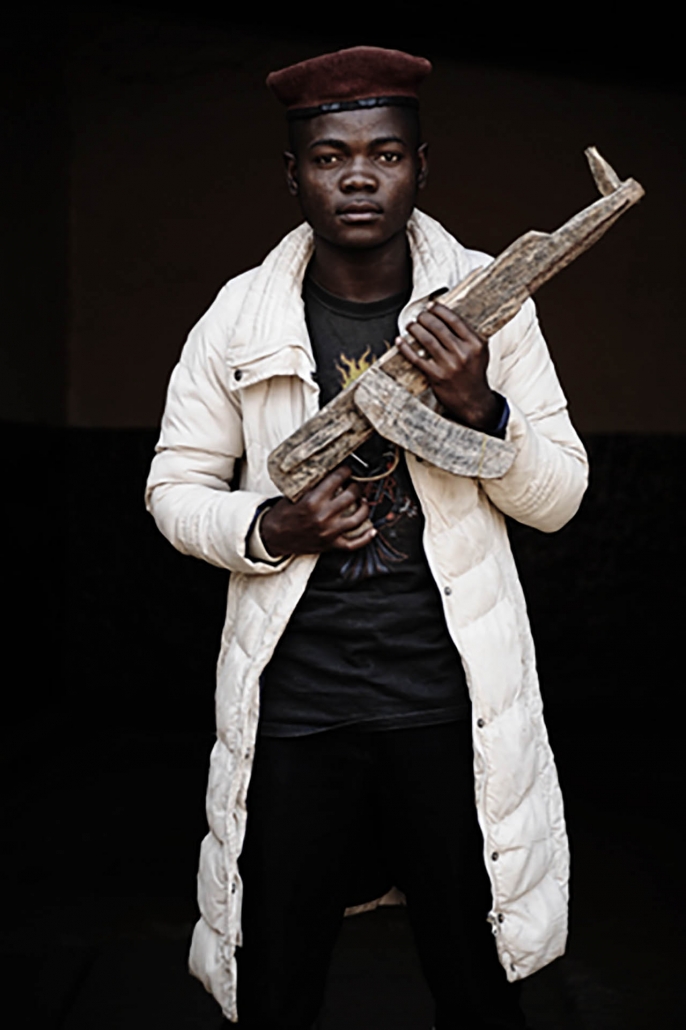This post is also available in:
 French
French
Bukavu, South Kivu province
Democratic Republic of Congo – 2013
The Great African War, or the Second Congo War, has seen the biggest death toll since World War Two. In Congo alone, the number of deaths is estimated at three to six million since 1998. This conflict has killed more than the wars in Bosnia, Iraq and Afghanistan combined. And while it officially ended with the Pretoria peace agreement in June 2003, it still drags on, even today, in the far east of the country, in the provinces of North and South Kivu. The war has gone on for a long time because everyone benefits from it: multinational companies, vendors of ores and minerals, dictators in neighbouring countries, but also ordinary citizens who can at last earn some money after the years of misery under Mobutu. The economy revolves around the military, and violence is now for sale. Soldiers offer their services to whomever is ready to pay them. You could easily mistake ethnic hatred for commercial competition.
Forcibly conscripted, or voluntary – out of a desire for vengeance or simply to survive – there are thousands of children in the armed groups. They are called “Kadogo”. They are the same children that Kabila and his foreign allies used to overthrow Mobutu. They have been taught to fight and the steal bounty from rival groups. They come cheap, and are happy to join the militia for a little money and the promise of lucrative pillaging. Add some drugs, and they fear nothing. Some porridge and a handful of beads is all the Maï Maï children need to go to the front, armed only with spears and machetes. Some food and clothes, and the girls offer themselves to the soldiers. At the height of the war, it was estimated that there were thirty thousand children living with the armed groups, a sad record for the Democratic Republic of Congo. The UN launched several campaigns of demobilisation when the peace treaty was signed in 2003, which freed eighteen thousand children who were reintegrated into society. The Office for Voluntary Aid for Children and Health, known as BVES, with the support of MONUSCO, (the UN Mission for Stability in Congo) and in partnership with UNICEF, has managed to liberate four-and-a-half thousand child soldiers. In this month of July 2013, at the BVES centre in Bukavu, there are eighty former child soldiers freshly arrived from the army. Many of them have killed, pillaged or raped. They have seen death at first hand, and have known hunger, drugs, alcohol, loneliness, abandon and prostitution. Even though they are between 12 and 17 years old, they are no longer really children. The army has given them everything. Arms are their fathers and mothers and have forged their identity.
Bukavu, provincia de Kivu Sur
República Democrática del Congo – 2013
La Gran Guerra Africana, o la segunda guerra del Congo, se ha convertido en la más mortífera después de la Segunda Guerra Mundial. Desde agosto de 1998 se estima entre tres a seis millones de víctimas, solo en el Congo. El conflicto ha matado más personas que las guerras de Bosnia, Irak y Afganistán juntas. Si oficialmente terminó en junio de 2003 con el acuerdo de paz de Pretoria, hoy continúa aún al este del país, en las provincias de Kivu-Norte y Kivu-Sur. Y si dura tanto tiempo es porque hay muchos intereses. Las grandes multinacionales, los revendedores de productos básicos, las dictaduras de los países vecinos, pero también los simples ciudadanos que pueden finalmente ganar algo de dinero después de años de miseria bajo el poder de Mobutu. La economía se ha militarizado y la violencia se comercializa. Los soldados ofrecen sus servicios, a condición de ser pagados. El odio étnico se parece mucho a la competencia comercial.
Enrolados por la fuerza o voluntarios, para vengarse o para poder comer, miles de niños aparecen en los grupos armados. Se los llama kadogos. Esos mismos niños que Kabila y sus aliados extranjeros habían utilizado para derrocar a Mobutu. Se les enseñó a luchar y a robar minerales en manos de grupos enemigos. Los niños son baratos y con poco dinero o una simple promesa de saqueos rentables, se unen enseguida a la milicia. Con un poco de droga, no temen a nada. Para los Mai Mai, basta con una sopa y algunas brujerías para que estos niños pasen al frente en primera línea, sin armas de fuego, simplemente con lanzas y machetes. Algunos alimentos y ropas son suficientes para que las jovencitas se entregan a los soldados. En el apogeo de la guerra, se avanzaba la cifra de 30 000 niños que vivían en los grupos armados. Un triste récord mundial para la República Democrática del Congo. Operaciones de desmovilización fueron implementadas por la ONU desde la firma del acuerdo de paz en 2003. Logrando reintegrar a la sociedad 18 000 niños. El BVES (Centro de Servicio Voluntario para la Infancia y la Salud), con el apoyo de la MONUSCO (Misión de la ONU para la Estabilidad del Congo), en colaboración con UNICEF, ha logrado desde 1996 desmovilizar a 4 500 niños soldados. En Bukavu, en julio de 2013, en el centro BVES, 80 niños soldados fueron liberados de los grupos armados. Muchos han matado, robado y violado. Han visto la muerte, han conocido el hambre, las drogas, el alcohol, la soledad, el abandono, la prostitución. Tienen entre 12 y 17 años y en realidad no son más niños. El ejército les dio todo. El ejército es su padre, su madre y quien forjó su identidad.



